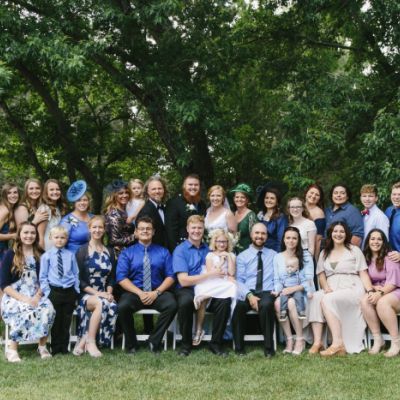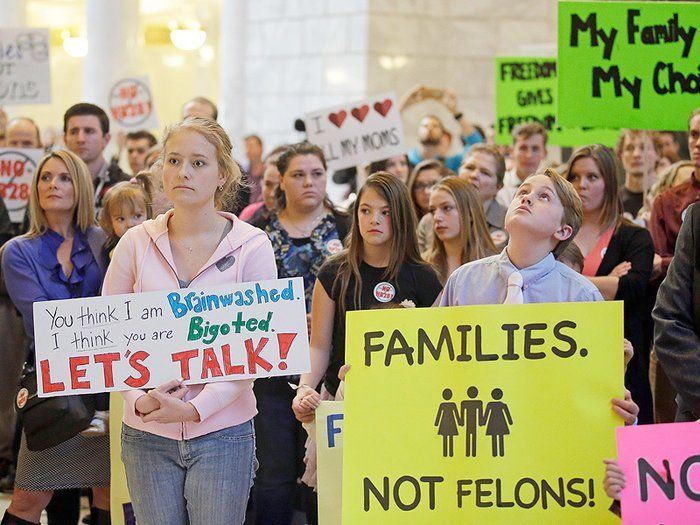What Is Polygamy?
Table of Contents
- Definition of Polygamy
- Polygamy in Different Cultures
- What Are the Three Types of Polygamy?
- Attitudes about Polygamy in Today's Religions
- Polygamy in Hinduism
- Polygamy in Buddhism
- Polygamy in Celtic Traditions
- Polygamy in Judaism
- Polygamy in Christianity
- Polygamy in the Roman Catholic Church
- Polygamy and the Movement of the Latter-day Saints
- Polygamy and Mormon Fundamentalism
- Polygamy and the Community of Christ
- Polygamy in Islam
- Legalization - Where Is Polygamy Legal?
Definition of Polygamy
What is the true meaning of polygamy? The practice of marrying numerous spouses is known as polygamy (from the Late Greek "state of many spouses").
Monogamy, on the other hand, is defined as a marriage between just two people. Like "monogamy," the term "polygamy" is frequently used in a de facto meaning, regardless of whether the state recognizes the relationship. Polygamy is a wide term used by academics in sociobiology and zoology to describe any multiple mating.
Polygamy in Different Cultures
Polygamy is either encouraged, accepted, or outlawed in many civilizations across the world. Polygyny is acceptable in the great majority of societies that allow or tolerate polygamy. According to the Ethnographic Atlas (1998), 588 of the 1,231 cultures studied had frequent polygyny, 453 had occasional polygyny, 186 were monogamous, and 4 had polyandry; nevertheless, new research shows polyandry is more prevalent than previously assumed. There have been mentions of polygamy in the bible. "The Bible mentions over 36 identified males who had more than one wife," says a religious scholar. Polygamy is typically linked to class and social position in societies where it is practiced.
In many nations, while marriage is officially monogamous (a person can only have one spouse, and bigamy is prohibited), adultery is not, resulting in a scenario where de facto polygamy is permitted but without legal recognition for non-official "spouses."
Based on surveys of world populations and features of human reproductive physiology, scientific research has shown that the human mating system is fairly polygynous.
What Are the Three Types of Polygamy?
There are three kinds of polygamy:
- Polygyny is a condition in which a guy has several wives at once.
- Polyandry is a type of polygamy in which a woman has several spouses at the same time.
- Multiple men and wives create a family unit in a group marriage.
Some species, such as the common fruit fly Drosophila melanogaster, are polygamous.
Polygyny
Incidence
The most frequent type of polygamy is polygyny, which is when a man has many wives at the same time. Polygyny is allowed in many Muslim-majority and Muslim-majority nations and some secular ones to various degrees.
Polygyny is more common in Africa than in any other continent, particularly in West Africa. Some historians believe that the slave trade's influence on the male-to-female sex ratio was a significant role in the rise and strengthening of polygynous behaviors in African countries.
In most Sub-Saharan African civilizations, anthropologist Jack Goody's comparative study of marriage using the Ethnographic Atlas revealed a historical link between widespread shifting horticulture and polygamy. Goody adds that the gender distribution of labor differs between male-dominated intense plow-agriculture in Eurasia and widespread shifting horticulture in Sub-Saharan Africa, citing the work of Ester Boserup. Women perform the majority of the struggle in parts of Africa's sparsely inhabited shifting agriculture areas. It encourages polygamous marriages, where males seek to dominate women "that are valued both as laborers and as child bearers." Goody, on the other hand, points out that the correlation is imperfect and varied and discusses more traditionally male-dominated but relatively extensive farming systems like those found in much of West Africa, particularly in the West African savanna, where polygyny is desired more for the creation of male offspring whose labor is valued.
In their book "Causes of Polygyny: Ecology, Economy, Kinship, and Warfare," anthropologists Douglas R. White and Michael L. Burton examine and defend Jack Goody's findings of African male farming systems, writing, "Goody (1973) speaks against the female contributions theory." He refers to Dorjahn's (1959) comparison of East and West Africa, which shows higher female agricultural contributions in East Africa and higher polygyny rates in West Africa, particularly in the West African savanna, where male agricultural subsidies are particularly strong. "The motivations for polygyny are sexual and reproductive rather than economic and productive," writes Goody (1973:189), claiming that men marry polygonally to maximize their fertility and establish huge families with many young dependent males.
Types of polygyny
There are two forms of polygynous marriages: sororal polygyny, in which the co-wives are sisters, and non-sororal polygyny, in which the co-wives are not related. Polygyny permits men to have more offspring, may supply them with a bigger number of productive employees (where those workers are family), and helps them to have politically beneficial relationships with a wider number of kin groupings. Senior women may also profit from the addition of younger wives to the household since it reduces their workload. Spouses' standing in society might arise with the arrival of additional wives who contribute to the family's riches or signify ostentatious expenditure (much like how a large house, domestic help, and expensive vacations operate in a western country). For these reasons, senior women may occasionally work longer hours or donate money from their own pockets to help their husbands save enough for the bride price of a second wife.
Levirate marriage can potentially result in polygyny. In such circumstances, the deceased man's heirs may inherit his possessions and wife, or his brothers may marry the widow, which is more common. It offers assistance for the widow and her children (general members of the brothers' kin group) while also keeping the husbands' and wives' kin groups together. A widower must marry his late wife's sister in the sorority, similar to the levirate. In other words, the late wife's relatives must find someone to replace her to keep the marriage together. A guy can have numerous wives through both levirate and sorority.
In monogamous civilizations, affluent and powerful men maintained long-term relationships with many female companions and set up separate households for them, in addition to their lawful spouses; this practice was allowed in Imperial China until the Qing Dynasty (1636-1912). It is known as concubinage, which is a type of de facto polygyny.
Household organization
Marriage is the beginning of a new home; however, depending on the type of marriage, different arrangements may arise, and some polygamous marriages do not establish a single household. In many polygynous marriages, the husband's wives may reside in separate houses, sometimes far apart. As a result, they may be defined as a "collection of connected nuclear families that share a father."
Polyandry
Incidence
Polyandry, or having many husbands simultaneously, is far less common than polygyny and is currently banned in almost every country on the planet. Only isolated communities are affected.
Polyandry is thought to be more common in civilizations with limited natural resources because it is believed to decrease the human population and improve infant survival. It is an uncommon type of marriage found not just among the impoverished but also among the wealthy. Polyandry, for example, is linked to the land shortage in the Himalayan Mountains; marrying all of a family's brothers to the same bride permits family land to stay intact and undivided. [Required citation] Family land would be divided into unsustainable tiny parcels if each brother married and produced children independently.
Types of polyandry
Nomadic Tibetans in Nepal, portions of China, and northern India used to practice fraternal polyandry, in which two or more brothers married the same lady. It is particularly prevalent in civilizations with a high male death rate. It's linked to partible paternity, the notion that a kid can have many fathers.
Non-fraternal polyandry occurs when the wives' husbands are unrelated. In the Nayar tribe of India, females marry before puberty, and their first husbands are recognized as a father of all their offspring. On the other hand, the lady is forbidden from cohabiting with that guy and must instead take several lovers; these men must pay the midwife to certify the paternity of their children (and so establish that no caste rules have been broken). The ladies live with their brothers in their maternal house, and property is passed down through the generations. Walking marriage, a matrilineal, de facto polyandry practiced by the Mosuo tribe of China, is a comparable form of matrilineal, de facto polyandry.
Group Marriage
Group marriage is one in which the family unit consists of more than two spouses. Each of them shares parental responsibility for any children born as a result of the union. Non-monogamy and polyamory are both forms of group marriage.
Serial Monogamy as Polygamy
Serial monogamy refers to remarriage after a monogamous marriage ends in the divorce or death of one of the spouses, i.e., numerous marriages but only one legal spouse at a time (a series of monogamous relationships).
Serial monogamy, which includes divorce and remarriage, is considered a type of polygamy by anthropologists since it may create a succession of houses connected by shared fatherhood and shared wealth, according to Danish academic Miriam K. Zeiten. As a result, they resemble the family structures that result from divorce and serial monogamy.
The "ex-" is a new type of relative created by serial monogamy. For example, the "ex-wife" can remain an active participant in her "ex-husband's" life since they may be linked by legally or informally required economic assistance, such as alimony, child support, and joint custody, which can endure for years. Bob Simpson points out that in the case of the United Kingdom, it forms an "extended family," or a group of homes linked together in this way, including mobile children, noting that Britons may have ex-wives or ex-brothers-in-law, but not ex-children. These "unclear families," he claims, do not conform to the monogamous nuclear family model.
Attitudes about Polygamy in Today's Religions
Polygamy in Hinduism
According to the Rig Veda, a man may have more than one wife during the Vedic time. Epics like the Ramayana and Mahabharata include references to the practice. The Dharmashastras allow a man to marry a woman from a lower caste if his first wife is also from a lower caste. Even though it existed, it was most commonly performed by males of higher castes and positions. Only if the first wife was unable to bear a son was a second marriage permitted.
The number of spouses is related to the caste system, according to Vishnu Smriti:
- In the direct sequence of the (four) castes, a Brāhmaṇa may now have four wives.
- A Kshatriya, three;
- A Vaishya, two;
- A Shudra, one only.
Baudhayana Dharmasutra and Paraskara Grihyasutra establish this relationship between the number of permissible spouses and the caste system.
If the first wife cannot fulfill her religious obligations or bear a son, the Apastamba Dharmasutra and Manusmriti allow for a second wife.
Only one wife may be the primary consort of a Brahmana, performing religious ceremonies (Dharma-Patni) alongside the husband. The primary consort had to be from the same caste as him. The eldest wife is the primary consort if a guy marries numerous women from the same caste. Hindu rulers frequently had more than one wife, and the texts often ascribe four wives to them. Mahisi, the primary consort, Parivrkti, who had no son,Vaivata, the favored wife, and Palagali, the daughter of the last of the court officials, were among them.
Polyandry, where a woman marries more than one guy, is another tradition that isn't extensively recorded. The Pandavas were five spouses for Draupadi in the Mahabharat epic.
If the first wife was unable to bear a son, Hindu tradition permitted polygamy.
Polygamy in India was declared illegal in 1955 by the Hindu Marriage Act, which the Indian Parliament adopted. Hindus were allowed to practice polygamy before 1955. The religion of the parties in issue determines the marriage rules in India.
Polygamy in Buddhism
Marriage is not a sacrament in Buddhism. It is entirely a secular affair in which monks do not participate. However, priests and monks do marry in some groups. As a result, it is not religiously sanctioned. As a result, marriage forms differ from country to country. "A man who is not happy with one lady and seeks out other ladies is on the path to decline," according to the Parabhava Sutta. Other bits of Buddhist scriptures appear to be critical of polygamy, leading some scholars to conclude that Buddhism as a whole opposes it or that it is an accepted but inferior marriage arrangement.
Thailand acknowledged polygyny until 2010. Since 2015, Myanmar has made polygyny illegal. Polyandry was used in Sri Lanka until recently (albeit not widely). Others' concubines were added to the list of unsuitable spouses when Buddhist teachings were translated into Chinese. Polyandry, like polygyny, was prevalent in Tibet in the past, and having several wives or husbands was never seen as having sex with unsuitable people. In today's world, Tibet is home to the world's largest and most prosperous polyandrous society. Typically, fraternal polyandry is practiced, however in certain cases, father and son share a bride, creating a world-first family arrangement. There are also other types of marriage, such as group marriage and monogamy. In Bhutan, Ladakh, and other regions of the Indian subcontinent, polyandry (particularly fraternal polyandry) is also popular among Buddhists.
Polygamy in Celtic Traditions
Although the Celtic peoples fluctuated between polygamy, monogamy, and polyandry depending on the period and region, certain pre-Christian Celtic pagans practiced it. The Brehon Laws of Gaelic Ireland, for example, clearly allowed for polygamy, especially among the aristocratic class, even after Christianization began. Polygamy is tolerated to different degrees in certain current Celtic pagan faiths. However, it is unknown how common the practice is.
Polygamy in Judaism
Exodus 21:10 says, "If he takes another wife for himself, her food, clothes, and the marital obligation must not be diminished." Deuteronomy 21:15–17 indicates that a man must give the inheritance owed to a firstborn son to the son who was born first, even if he despises that boy's mother and prefers another woman. Deuteronomy 17:17 states that a king must not have too many wives.
With the prefix "to," the Torah may distinguish between concubines and "sub-standard" brides (e.g., lit. "took to wives"). Despite these variations in the biblical attitude on polygamy, several prominent characters, such as Esau (Gen 26:34; 28:6-9), Jacob (Gen 29:15-28), Elkanah (1 Samuel 1:1-8), David (1 Samuel 25:39-44; 2 Samuel 3:2-5; 5:13-16), and Solomon (1 Samuel 25:39-44; 2 Samuel 3:2-5; 5:13-16), had multiple wives (1 Kings 11:1-3).
In the case of famine, widowhood, or female infertility, multiple marriages were regarded as a viable option, as in the practice of levirate marriage, in which a man was obligated to marry and support his deceased brother's widow as prescribed by Deuteronomy 25:5-10. Despite its presence in the Hebrew Bible, academics think that polygyny was not widely practiced throughout the ancient era since it necessitated a substantial amount of wealth. "Polygyny continued to be practiced long into the biblical period, and it is documented among Jews as late as the second century CE," according to Michael Coogan.
The Roman Empire's monogamy was the source of two explanatory remarks in Josephus' writings detailing how Herod the Great's polygamous marriages were permissible under Jewish law.
Polygamy was tolerated throughout the Rabbinical era, which started with the destruction of the second temple in Jerusalem in 70 CE. "Raba said: [If a man proclaims,] 'Be thou betrothed to half of me,' she is betrothed: 'half of thee be betrothed to me,' she is not betrothed," according to Kiddushin 7a of the Babylonian Talmud (BT). The BT appears to replicate the precedent set in Exodus 21:10 when discussing Levirate marriage in Yevamot 65a: "Raba said: a man may marry women in addition to the first wife; provided that he had the wherewithal to sustain them." Polygamy was outlawed in Judaism thanks to the Jewish Codices.
In his Mishneh Torah, Maimonides argued that polygamous marriages were legitimate, despite his personal beliefs to the contrary. While preserving the privilege of numerous weddings and the obligation to provide completely for each, the Mishneh Torah went even further: "He is not, however, permitted to compel his women to share a courtyard. Rather, each person has the right to their own house",
The Talmud's lone example of a polygamous rabbi serves as an outstanding illustration: Rabbi Tarfon married 300 women throughout his lifetime. Why? There was a famine in the country. Rabbi Tarfon, on the other hand, had plenty of food since he was a kohen and got priestly tithes. A kohen's wife is likewise allowed to consume those tithes. Those 300 women were delighted that the Torah had made polygamy legal.
The Shulchan Aruch adds further subtleties to all of the earlier works: "...however, in any case, our sages advise against marrying more than four women, unless he can fulfill their conjugal demands at least once a month. He is also not allowed to marry another woman over his current wife in a country where it is usual to marry just one wife." As can be seen, while the Rabbinic period's tradition began with establishing legal definitions for polygamy that corresponded to precedents in the Tanakh, by the time of the Codices, the Rabbis had drastically curtailed or eradicated the practice.
The synod of Rabbeinu Gershom was the most significant in the Rabbinic period on polygamy, albeit it was more especially for Ashkenazi Jews. Around 1000 CE, he summoned a synod to be deliberate on the following issues:
- Ban of polygamy.
- Requirement of both partners' permission to divorce.
- Revision of the regulations for people who were forced to become apostates.
- Restriction of opening mail sent to another.
Polygamy is practically non-existent in Rabbinic Judaism nowadays. Since the 11th century, Ashkenazi Jews have followed Rabbenu Gershom's prohibition. Several Mizrahi Jewish groups abandoned polygyny (especially Yemenite and Persian Jews) once they emigrated to places where it was prohibited or outlawed. Polygamy is illegal in Israel. However, the legislation is only weakly implemented in reality, largely to avoid interfering with Bedouin culture, which practices polygyny. This Israeli law does not apply to pre-existing polygynous marriage among Jews from Arab nations (or other places where the practice was not forbidden by their tradition and was not unlawful). In Israel, however, new polygamous marriages are not authorized for Mizrahi Jews. On the other hand, polygamy may still exist in non-European Jewish communities that live in countries where it is not prohibited, such as in Yemen and the Arab world.
Polygamy is practically non-existent nowadays among Karaite Jews who do not follow Rabbinic interpretations of the Torah. Karaites, like other Jews, interpret Leviticus 18:18 to mean that a man can only take a second wife if his first wife consents (Keter Torah on Leviticus, pp. 96–97), and Karaites interpret Exodus 21:10 to mean that a man can only take a second wife if he can maintain the same level of marital duties due to his first wife; the marital responsibilities are 1) food, 2) clothing and 3) sexuation. Because of these two scriptural limits, as well as the fact that it is illegal in most nations, polygamy is seen to be impracticable, and there are just a few known examples of it among today's Karaite Jews.
Polygamy is prohibited in Israel. Existing polygamous households were granted permission to immigrate from countries where the practice was lawful. Furthermore, former head rabbi Ovadia Yosef has advocated for the Israeli government to legalize polygamy and the method of pilegesh (concubine).
Tzvi Zohar, a professor at Bar-Ilan University, has argued that the notion of concubines might serve as a practical Halachic explanation for premarital or non-marital cohabitation, based on the opinions of prominent halachic scholars.
Polygamy in Christianity
Was there any mention of polygamy in the Bible? The Old Testament makes no mention of polygamy. Even though the New Testament is mostly quiet on polygamy, others refer to Jesus repeating older passages, stating that a man and his wife "will become one flesh." Some, on the other hand, turn to Paul's letters to the Corinthians: "Do you realize that when a man marries a prostitute, he becomes one body with her? 'The two will become one flesh,' as it is written." Polygamists argue that this proves the term refers to a physical union rather than a spiritual one.
Some Christian theologians claim that Jesus indicates in Matthew 19:3-9, referencing to Genesis 2:24, that a man should only have one wife:
Have you not read that he who created them, in the beginning, formed them male and female, and said, for this reason, shall a man leave his father and mother.
Polygamy should not be practiced by some church leaders, according to the New Testament. "A bishop must be blameless from these, the spouse of one wife, sober, of good character, dedicated to hospitality, apt to teach," 1 Timothy says (chapter 3, verse 2; see also verse 12 regarding deacons having only one wife). In the first chapter of the Epistle to Titus, similar advice is given.
Periodically, Christian reform groups that have attempted to reconstruct Christian theology based only on the Bible (sola scriptura) have recognized polygyny as a Biblical practice, at least briefly. For example, during the Protestant Reformation, Martin Luther granted Landgrave Philip of Hesse, who was living "constantly in a state of adultery and fornication" for many years, a dispensation to take a second wife in a document known simply as "Der Beichtrat" (or "The Confessional Advice"). However, to prevent public controversy, the double marriage had to be carried out in secret. Luther had previously said in a letter to the Saxon Chancellor Gregor Brück that he could not "forbid a person to marry numerous wives since it does not contradict Scripture," and that he could not "forbid a person to marry several wives, because it does not contradict Scripture." ("Ego sane factor, me non posse prohibited, if plures velit uxores ducere, nec repugnant sacris literis.")
There has long been a conflict in Sub-Saharan Africa between the Christian stress on monogamy and customary polygamy. Mswati III, the Christian monarch of Swaziland, for example, had 15 wives. There have been recent attempts for accommodation in certain cases; in others, churches have fought such moves vehemently. In justifying polygamy, African Independent Churches have resorted to sections of the Old Testament that mention the practice.
Polygamy in the Roman Catholic Church
The Roman Catholic Church condemns polygamy; the Catechism of the Catholic Church mentions it under the heading "Other crimes against the dignity of marriage" in paragraph 2387 and declares that it "is not following the moral law." In addition, in paragraph 1645, under the heading "The oneness of marriage, clearly acknowledged by our Lord, is made evident in the equal personal dignity which must be granted to husband and wife in reciprocal and unreserved devotion," according to "The Goods and Requirements of Conjugal Love." Polygamy is incompatible with undivided and exclusive marital love."
Polygamy in the Old Testament was a source of contention for Saint Augustine. He abstained from passing judgment on the patriarchs, but he did not infer from their behavior that polygyny was still acceptable. On the contrary, he said that the Fathers' polygamy, which the Creator permitted because of its fecundity, was a deviation from His original purpose for human marriage. "The beneficial aim of marriage is better to serve by one husband with one wife, than by a husband with numerous wives, is demonstrated simply enough by the very first marriage pair, which was formed by the Divine Being Himself," Augustine said.
Augustine believed that patriarchs had numerous wives because they desired more offspring, not because of immorality. He backed up his claim by demonstrating that their marriages, in which the husband was the head, were structured according to management principles: those in charge (quae principantur) in their society were always single. At the same time, subordinates (subiecta) were many. He provided two examples: dominus-Servus - master-servant (in an earlier translation: slave) and God-soul. Worshiping many gods, often known as idolatry, is frequently equated with adultery in the Bible. "On this reason, there are no True Gods of souls, except One but one such," Augustine says.
Fertility was no longer an acceptable argument for polygamy as tribe populations grew: "I would not quickly declare whether it was lawful among the ancient ancestors, or if it is lawful now as well (utrum et nunc fas sit, non temere dixerim). Because there is no longer a need to have children, as there formerly was, when, even when spouses have children, it was permissible to marry several wives to have a larger posterity, which is no longer legal."
Augustine regarded marriage as an unbreakable commitment between one man and one woman. The Creator instituted monogamy: "Therefore, man and woman are the earliest natural bonds of human society." The Saviour's presence at the wedding at Cana (Matthew 19:9) and in the Gospel of Matthew (Matthew 19:9) verified such marriage (John 2:2). Marriage is a sacrament in the Church—the City of God—and may not and cannot be dissolved as long as the spouses live: "But a marriage once for all entered into in the City of our God, where, even from the first union of the two, the man and the woman, marriage bears a certain sacramental character, marriage can in no way be dissolved except by the death of one of the spouses." "For it is in a man's power to put away a barren wife, and marry one of whom to have children," Augustine pointed out in Chapter 7 that the Roman Empire forbade polygamy, even if the reason of fertility would support it: "For it is in a man's power to put away a barren wife, and marry one of whom to have children." But it is not permitted; and it is not allowed even now, in our days, and after the usage of Rome (nostris quidem iam temporibus ac more Romano), to marry in addition, to have more than one wife living. He goes on to say that the Church's position toward monogamy goes far further than the secular law: Remarrying is forbidden, as it is considered a kind of fornication: Except in the City of our God, on His Holy Mount, the situation with the womb is different.
In recent years, a small group of Roman Catholic theologians has maintained that, while not ideal, polygamy can be a valid form of Christian marriage in certain areas, particularly in Africa. The Catechism of the Roman Catholic Church says that "Polygamy is against the rule of morality. Polygamy fundamentally contradicts [conjugal] communion; in fact, it directly contradicts God's revealed purpose from the beginning, for it is incompatible with the equal personal dignity of men and women who, in matrimony, commit themselves to a whole and thus unique and exclusive love."
According to certain Bible texts, the illegality of polygamy in some regions adds to the grounds against it. "Submit to the authorities, not only for the sake of probable punishment, but also for the sake of conscience," Paul says in Romans 13:5, since "God has instituted the authorities that exist." (1 Corinthians 13:1) "Submit yourselves for the sake of the Lord to every authority created among men," writes St Peter, "whether to the king, as the ultimate authority, or to governors, who are sent by him to punish those who do evil and to praise those who do good." ' (1 Peter 2:13,14) Pro-polygamists believe that no laws are broken as long as polygamists do not get formal marriage licenses or seek "common law marriage status" for extra spouses, just as monogamous couples do not cohabitate without a marriage license.
Polygamy and the Movement of the Latter-day Saints
According to a revelation to Joseph Smith, the practice of plural marriage—the marriage of one man to two or more women—was introduced among members of The Church of Jesus Christ of Latter-day Saints in the early 1840s. Despite Smith's revelation, polygamy was officially denounced in the 1835 version of the Concept and Covenants' 101st Section, published after the doctrine of plural marriage began to be practiced. In Liverpool, England, in 1850, John Taylor used this scripture to dispel Mormon polygamy allegations. Several senior Mormon leaders, including Smith, Brigham Young, and Heber C. Kimball, declared polygamy illegal in Illinois during the 1839–44 Nauvoo period. Kimball has several wives. Elders of the Church of Jesus Christ of Latter-day Saints who openly preached that all males were ordered to engage in multiple marriages were severely reprimanded. The Nauvoo Expositor chastised Smith for numerous weddings on June 7, 1844.
The Church of Jesus Christ of Latter-day Saints is a religious organization dedicated to the restoration of the gospel of Jesus Christ to the world (LDS Church)
Following Joseph Smith's assassination by a mob on June 27, 1844, most Latter-day Saints fled Nauvoo and accompanied Brigham Young to Utah, where plural marriage was still practiced. In a speech delivered in 1852, Brigham Young, the second president of the LDS Church, openly recognized the practice of multiple marriages. Following that, senior Mormon leaders delivered more sermons on the benefits of polygamy. When polygamy became a societal concern, it sparked debate, and writers began to produce works criticizing the practice.
"To ban throughout the territories those twin remnants of barbarism, polygamy, and slavery," the Republican Party's platform said in 1856. In 1862, Congress passed the Morrill Anti-Bigamy Act, making polygamy illegal in all US territories. The LDS Church believed that the United States Constitution protected their religiously based practice of plural marriage. Still, the unanimous 1878 Supreme Court decision Reynolds v. the United States declared that polygamy was not covered by the Constitution, based on the longstanding legal principle that "Laws are designed to govern activities, and while they cannot regulate religious beliefs and ideas, they may regulate behaviors."
Some Mormons emigrated to Canada and Mexico when anti-polygamy legislation became more severe in the United States. In 1890, LDS Church president Wilford Woodruff made a public statement (the Manifesto) declaring the end of new plural marriages. Anti-Mormon hatred, as well as resistance to Utah becoming a state, began to fade. The Smoot Hearings in 1904, which revealed that the LDS Church was still practicing polygamy, prompted the church to release a Second Manifesto, declaring that new plural marriages were no longer being performed. By 1910, people who entered into or executed multiple unique weddings were excommunicated by the LDS Church. Despite this, many spouses and wives continued to live together until the 1940s and 1950s, when they died.
Various breakaway organizations left the LDS Church to maintain the practice of multiple marriages after the year 1890 Manifesto was enforced. Polygamy is still practiced among these communities in Utah and adjacent states, and the spin-off colonies. Even though they are not affiliated with the LDS Church, polygamist congregations of Mormon heritage are sometimes referred to as "Mormon fundamentalists." Such fundamentalists sometimes cite a supposed 1886 revelation to John Taylor as justification for practicing multiple marriages. According to the Salt Lake Tribune, there were 37,000 fundamentalists in 2005, with less than half living in polygamous families.
In Brown v. Buhman, US Federal Judge Clark Waddoups found that sections of Utah's anti-polygamy statutes prohibiting repeated cohabitation were unconstitutional but that the state's prohibition on multiple marriage licenses was upheld. Since the 1882 Edmunds Act, the principal tactic used to prosecute polygamy in Utah has been unlawful cohabitation, in which prosecutors did not need to establish that a marriage ceremony had taken place (just that a couple had lived together).
Polygamy and Mormon Fundamentalism
The Council of Friends (also known as the Woolley Group or the Priesthood Council) was one of the first manifestations of Mormon fundamentalism, with its roots in the teachings of Lorin C. Woolley. This dairy farmer was expelled from the LDS Church in 1924. The Fundamentalist Church of Jesus Christ of Latter-Day Saints (FLDS Church), the Apostolic United Brethren, the Centennial Park group, the Latter-Day Church of Christ, and the Righteous Branch of the Church of Jesus Christ of Latter-Day Saints are just a few of the Mormon fundamentalist groups that claim lineage through the Council of Friends.
Polygamy and the Community of Christ
Since its founding in 1860, the Community of Christ, formerly known as the Reorganized Church of Jesus Christ of Latter-day Saints (RLDS Church), has never sanctioned polygamy. Following the Reorganization of the church, Joseph Smith III, the first Prophet-President of the RLDS Church, was an outspoken opponent of plural marriage throughout his life. For most of his career, Smith denied that his father was involved in the practice, insisting that Brigham Young was the one who started it. Smith went on several expeditions to the western United States, where he met and questioned acquaintances and ladies claiming to be his father's widows, who tried to persuade him otherwise. When confronted with such allegations, Smith would generally react by claiming that was "neither positive nor confident that [his father] was innocent" and that even if the older Smith was engaged, it was still a fraudulent practice. Many members of the Community of Christ and other previously affiliated groups do not believe that Joseph Smith practiced multiple marriages and believe that the evidence that he did is faulty.
Polygamy in Islam
A Muslim man may have up to four wives simultaneously, given reasonable and justified conditions, according to Islamic marital doctrine. Under no circumstances is it permissible for a Muslim woman to have more than one spouse simultaneously.
The perfect relationship, according to Quran verse 30:21, is the comfort that a couple finds in each other's embrace:
"And among His Signs is this: He chose for you mates from among yourself, so that you may live in peace with them, and He has placed love and kindness between your (hearts): indeed, in that are Signs for people who ponder."
— Sura 30 (Ar-Rum), Ayah 21 of the Qur'an
Polygyny is permitted in the Koran only in exceptional circumstances. According to Islamic law, when a man marries more than one woman, he must treat them equally in terms of financial assistance and support provided to each wife. If a guy worries he won't be able to treat his wives fairly, Islam recommends monogamy. It is based on Quran verse 4:3, which says:
"If you are concerned that you will not be able to treat orphans fairly, Marry the woman you want, Two, three, or four; but if you are afraid that you will not be able to deal justly with them, then simply one, or one that is in your right hands, will be enough to keep you from doing injustice."
— Sura 4 (An-Nisa), Ayah 3 of the Qur'an
Muslim women are not permitted to marry many husbands at the same time. However, if their spouses divorce them or die, women can remarry once Iddah is completed, as divorce is allowed under Islamic law. Because her marriage with her non-Muslim spouse is Islamically dissolved on her leaving, a non-Muslim woman who adopts Islam and escapes from her non-Muslim husband has the choice to remarry without having to divorce her prior husband. A non-Muslim woman taken by Muslims during a battle can remarry since her marriage to her non-Muslim husband is Islamically dissolved at the time of captivity. This permission is granted to such ladies in Quranic verse 4:24. In contrast to prostitution, the verse also emphasizes transparency, mutual consent, and financial remuneration as criteria for marital relationships; it says:
"Women previously married, except those in your right hands, are also prohibited: (Prohibitions) have been established by Allah against you as follows: Except for these, all others are legal if you seek (them in marriage) with gifts from your property, desiring chastity rather than lust, and seeing that ye derive benefit from them, give them their dowers (at least) as prescribed; but if you agree Mutually (to vary a dower after it has been specified), there is no blame on you, and Allah is All-knowing and All-wise."
— Sura 4 (An-Nisa), Ayah 24 of the Qur'an
Muhammad's first wife, Khadija, was his monogamous wife for 25 years until she died. For social and political reasons, he married a number of women after she died. The majority of them were widows. According to reports from his lifetime, he had nine wives in all, but not all at the same time. The Qur'an makes no distinction between husbands who have more than one wife. One argument for polygyny is that it permits a guy to provide financial security to several women who might otherwise be alone (e.g., widows). The wife, on the other hand, might stipulate in the marriage contract that the husband cannot marry another woman while they are married. In this situation, the husband is prohibited from marrying another lady while still married to his wife. Each of those wives, according to traditional Islamic law, retains her property and assets separately and is given Mahar and maintenance separately by her husband. The women usually have little to no contact with one another and live separate lives in their own homes, sometimes in different cities, even though they all have the same spouse.
Polygyny is permitted in most Muslim-majority nations, with Kuwait being the only one that does not have any limitations. In Muslim-majority Turkey, Tunisia, Albania, Kosovo, and Central Asian nations, the practice is prohibited.
Polygyny is often permitted in countries that require a man to get permission from his prior wives before marrying another, as well as proving that he can financially support several women. A man must justify taking an additional wife during a court hearing in Malaysia and Morocco before being allowed to do so. To expand the population in Sudan, the government supported polygyny in 2001.
Legalization - Where Is Polygamy Legal?
Polygamy and the International Law
The United Nations Human Rights Committee has formed in the year 2000 that polygamy violates the International Covenant on Civil and Political Rights (ICCPR), citing concerns that were lack of "equality of treatment concerning the right to marry" meant that polygamy, limited to polygyny in practice, violated women's dignity and should be outlawed. Reports to UN Committees have specifically identified breaches of the ICCPR due to these disparities, and information to the UN General Assembly has urged that it be prohibited. Many Muslim nations, including Saudi Arabia, the United Arab Emirates, Qatar, Malaysia, Brunei, Oman, and South Sudan, are not signatories to the International Covenant on Civil and Political Rights (ICCPR). Therefore, the UN treaty does not apply to them.
Polygamy in the United Kingdom
In the United Kingdom, bigamy is prohibited. De facto polygamy (having many partners simultaneously) is not a crime as long as the person does not register more than one marriage. Adultery is not a crime in the United Kingdom (it is only a ground for divorce). In a written response to a question from the House of Commons, "Polygamy is only recognized as legal in the United Kingdom if the marriage ceremony took place in a nation where polygamy is legal, and the parties to the marriage were domiciled there at the time. Furthermore, since 1988, immigration laws have largely prohibited the creation of polygamous families in the United States."
The UK government's Universal Credit (UC) will not recognize polygamous marriages, which will replace means-tested benefits and tax credits for working-age individuals and will not be fully implemented until 2021. "Treating second and subsequent partners in polygamous relationships as distinct claimants might mean that polygamous families get more under Universal Credit than they do under the existing regulations for means-tested benefits and tax credits," according to the House of Commons Briefing Paper. As previously stated, the amounts that must be paid for additional spouses are smaller than those that apply to single claimants. Official statistics on cohabiting polygamous couples who have married in religious ceremonies are presently unavailable.
In October 2017, a dating service providing Muslim men the option to find second or third spouses received media attention in the United Kingdom. The website had 100 000 users, 25 000 of which were from the United Kingdom. When website founder Azad Chaiwala was looking for a second wife, he developed the website.
Polygamy in the United States
In the United States, polygamy is prohibited. Despite religious concerns from The Church of Jesus Christ of Latter-day Saints (Mormons), the Supreme Court upheld federal legislation banning the practice in Reynolds v. the United States in 1878.
On December 13, 2013, a federal court threw down portions of Utah's bigamy statute that criminalized cohabitation, but admitted that the state may still enforce restrictions on possessing multiple marriage licenses, thanks to the American Civil Liberties Union and other organizations.
Individualist feminism and proponents like Wendy McElroy and journalist Jillian Keenan believe that adults should willingly engage in polygamous relationships.
Authors like Alyssa Rower and Samantha Slark argue that there was a case of legalizing Polygamy based on regulation and monitoring practice, legally protecting polygamous partners, and allowing them to participate in mainstream society rather than being forced to hide from it when a public situation arises.
Jonathan Turley, a law professor at George Washington University, claimed in an op-ed for USA Today in October 2004 that polygamy should be allowed it is a question of equal treatment under the law. Although Turley acknowledged that teenage girls are occasionally forced into polygamous marriages, he responded that "prohibiting polygamy is no more a remedy to child abuse than banning marriage is a solution to spousal abuse."
Comments:
Related Articles
-
 Legalize Polygamy: Study
Aug 31 '2018, 2:47 PM
Legalize Polygamy: Study
Aug 31 '2018, 2:47 PM
-
 Judge To Decide Future Of Polygamous Towns In Arizona, Utah
Aug 31 '2018, 2:52 PM
Judge To Decide Future Of Polygamous Towns In Arizona, Utah
Aug 31 '2018, 2:52 PM
-
 Thom Miller: Pastor marries pregnant girlfriend with consent of his wife
Aug 31 '2018, 3:55 PM
Thom Miller: Pastor marries pregnant girlfriend with consent of his wife
Aug 31 '2018, 3:55 PM
-
 Germany to end unofficial tolerance of polygamy
Aug 31 '2018, 3:48 PM
Germany to end unofficial tolerance of polygamy
Aug 31 '2018, 3:48 PM
-
 Sister Wives family makes home in inclusive Arizona city
Aug 31 '2018, 4:54 PM
Sister Wives family makes home in inclusive Arizona city
Aug 31 '2018, 4:54 PM
-
 Decriminalize Polygamy Kody Brown Fights For Plural Marriages
Aug 31 '2018, 8:15 PM
Decriminalize Polygamy Kody Brown Fights For Plural Marriages
Aug 31 '2018, 8:15 PM
-
 Polygamy In The Black Community
Sep 29 '2018, 10:08 PM
Polygamy In The Black Community
Sep 29 '2018, 10:08 PM
-
 All This Love but Why Do I Still Feel Low
Dec 5 '2018, 11:58 AM
All This Love but Why Do I Still Feel Low
Dec 5 '2018, 11:58 AM
-
 Men and Polygamy
Jan 26 '2019, 10:56 PM
Men and Polygamy
Jan 26 '2019, 10:56 PM
-
 Becoming Poly
Feb 4 '2019, 3:46 PM
Becoming Poly
Feb 4 '2019, 3:46 PM
Rate
Recent Articles
-
 Polyamory Secondary Partner
Apr 22, 2:26 PM
Polyamory Secondary Partner
Apr 22, 2:26 PM
-
 Polyamory Commitment Ceremony
Feb 20, 4:38 PM
Polyamory Commitment Ceremony
Feb 20, 4:38 PM
-
 Sister Wives Family Tree
Feb 4, 11:52 AM
Sister Wives Family Tree
Feb 4, 11:52 AM
-
 5 Polygamy Dating & Relationship Rules
Jan 22, 1:16 PM
5 Polygamy Dating & Relationship Rules
Jan 22, 1:16 PM
-
 Sister Wives Unveils a New Era of...
Jan 7, 8:51 AM
Sister Wives Unveils a New Era of...
Jan 7, 8:51 AM
Most Viewed
-
 Red Flags in Online Poly Dating
Apr 27 '2019, 10:47 PM
Red Flags in Online Poly Dating
Apr 27 '2019, 10:47 PM
-
 Polyamory, Being More Than Friends
Jan 26 '2020, 1:00 PM
Polyamory, Being More Than Friends
Jan 26 '2020, 1:00 PM
-
 Poly Love and Nosy Neighbors
May 2 '2019, 11:58 AM
Poly Love and Nosy Neighbors
May 2 '2019, 11:58 AM
-
 Know Your Poly Terms and Conditions
Aug 14 '2019, 1:16 PM
Know Your Poly Terms and Conditions
Aug 14 '2019, 1:16 PM
-
 A Direction For Polygamy
May 13 '2019, 10:16 AM
A Direction For Polygamy
May 13 '2019, 10:16 AM
Most Discussed
-
 Polyamory Secondary Partner
Apr 22, 2:26 PM
Polyamory Secondary Partner
Apr 22, 2:26 PM
-
 Seeking a Sister Wife: Emotional...
Sep 21 '2023, 3:37 PM
Seeking a Sister Wife: Emotional...
Sep 21 '2023, 3:37 PM
-
 Finding a Sister Wife: Online Etiquette
Jun 29 '2022, 10:23 PM
Finding a Sister Wife: Online Etiquette
Jun 29 '2022, 10:23 PM
-
 Sister Wife Meri Brown Thrives Amid...
Jun 21 '2021, 6:27 PM
Sister Wife Meri Brown Thrives Amid...
Jun 21 '2021, 6:27 PM
-
 Know Your Poly Terms and Conditions
Aug 14 '2019, 1:16 PM
Know Your Poly Terms and Conditions
Aug 14 '2019, 1:16 PM






